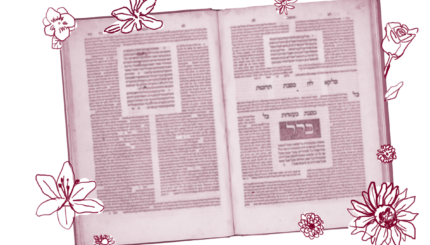In our world today, there are many professionals who are immediately recognizable by their uniforms and equipment: a chef’s toque, a medical provider’s scrubs, a coach’s stopwatch and whistle. As we were reminded yesterday, priests also wore a uniform. These clothes weren’t just a nice touch; we learned in a mishnah a few days ago that a sacrifice could be disqualified if the priest who offered it lacked the proper attire. On yesterday’s daf, the Gemara stated more boldly:
When their vestments are on them, their priesthood is upon them, but if their vestments are not on them, their priesthood is not upon them (and their rites are disqualified).
But here, too, gray areas abound: What qualifies as a proper uniform, exactly? In a time when off-the-rack clothing didn’t exist and the required garments might be ill-fitting hand-me-downs, how much alteration could a priest do and still be garbed appropriately for the sacrificial service? That’s the topic the Gemara explores today.
The sages taught: If the priest’s vestments were dragging on the ground, or raised up far from the ground, or frayed, and the priest performed sacrificial rites while wearing them — his service is valid. If he wore two pairs of trousers or two belts, or if he was lacking one of his requisite vestments, or if he wore one extra vestment, or in a case where a priest had a bandage on a wound on his body under his vestment such that the bandage acted as an interposition between the vestments and his skin, or if he wore vestments that were soiled or ripped, and he performed sacrificial rites — his service is disqualified.
According to the general opinion of the sages, conducting the service in a tunic that’s too long, too short or frayed doesn’t invalidate the sacrifice. In a general sense, the rabbis rule that the priest’s clothing doesn’t have to fit perfectly or be in mint condition in order for it to be usable. But changing the uniform by adding or subtracting items (even bandages that come between the garment and the skin!) or wearing something dirty or torn is unacceptable and invalidates the sacrifice.
Unsurprisingly, there are dissenting opinions:
Rav Yehuda says that Shmuel says: If the vestments are dragging on the ground, they are fit, but if they are raised up above the ground, they are unfit. But isn’t it taught in the above beraita that even if the vestments were raised up they are fit? Rami bar Hama says: This is not difficult. Here, the beraita deems them fit in a case where the priest raised them up by his belt, although they were initially the proper length; there, Shmuel deems them unfit in a case where they do not initially cover the priest’s feet at all. Rav says: In both this case and that case, whether they were dragging or raised up, they are unfit.
Priests did difficult and messy physical labor, so the desire to hike up one’s tunic is not surprising. At issue here is whether a priest can in fact use a belt to make a long garment shorter. The commentators, like the talmudic rabbis themselves, go back and forth on this issue, ultimately ruling (practically, perhaps) that a belt can be used to shorten a long garment.
The Gemara next goes to the question of material:
The sages say: The verse (Leviticus 6:3) states “linen” to indicate that they must be made of fine linen; it states “linen,” to indicate that they must be new; it states “linen” to indicate that their thread must be twisted of several plies; it states “linen,” to indicate that their thread must be folded six times; it states “linen,” to indicate that the priest may not wear non-sacred clothes along with them.
The Gemara interprets the biblical requirement that the priestly garments be completely made of linen to mean not just that a particular material is required, but also that the garments must be of a certain quality and woven in a particular manner. They tack on the prohibition that a priest cannot wear his own non-sacrificial clothes together with his linen uniform.
We’re left with the following general rules: Priests must wear specific linen vestments that need not fit perfectly and can be a little worse for wear. But wearing something dirty or off uniform is not permitted. These rules ensured that priests would be instantly recognizable and present themselves respectfully, not just to the people, but more importantly, to God.
Read all of Zevachim 18 on Sefaria.
This piece originally appeared in a My Jewish Learning Daf Yomi email newsletter sent on October 2, 2025. If you are interested in receiving the newsletter, sign up here.
With your help, My Jewish Learning can provide endless opportunities for learning, connection and discovery.



